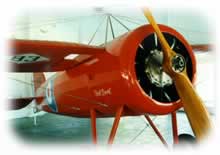The Bristol M1C Monoplane known as the Red Devil was built by the British and Colonial Aeroplane Company (later the Bristol Aeroplane Company) at Filton, England, and delivered to the Royal Flying Corps on the 4th February, 1918. The plane was designed with a certain urgency as the need for fast single seat fighter planes with the greatest possible fire power became apparent. The exceptional speed of the aircraft was later typified by Captain Butler’s claim in July 1919 that “my plane is one of the three fastest in the world.”

A small production run of 125 planes were constructed which together with its then radical design led to a high unit cost of £770 (without engine, instruments and gun). The engine cost an additional £771. The plane was first flown on the 28th May, 1916, by the ‘E’ Flight of No. 4 Auxiliary School for Aerial Gunnery R.F.C. at Marske-by-the-Sea Yorkshire. Entries in the aircraft’s Log Book indicated that it had been used for “Fighting Practice” for 20 minutes per day from June to September, 1918. The final entry in the log books while owned by the R.F.C. was made on 25th January, 1919.
After Captain Harry Butler’s death in 1924, the plane was hung form rafters in a shed in Adelaide. The castor oil lubricant from its flying days had caused an oily, dirty, film to develop on the fabric of the aircraft.
Mr. C. Miller purchased the plane from Captain Butler’s widow in about 1930, and proceeded to restore the plane. The fuselage was subsequently altered to a rectangular shape to house two different types of engines.
Mr. Miller competed in races in Adelaide and Melbourne and flew in exhibitions in the following years. The Monoplane was also flown during the time by a Mr. Kleinig – only the third to pilot the plane in its privately owned lifetime. The plane was never involved in an accident. Just prior to World War II, Miller flew the aircraft from Adelaide to Perth for exhibition flying until approximately 1945, when the plane was officially retired from flying.



